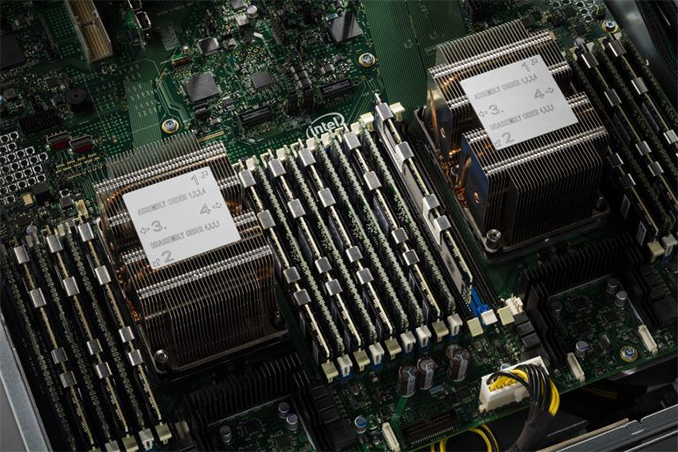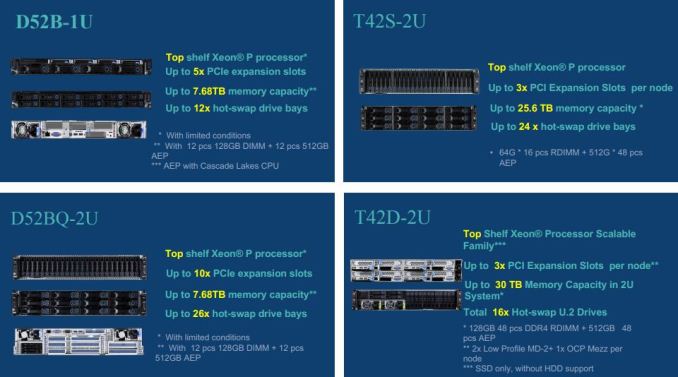Intel’s High-End Cascade Lake CPUs to Support 3.84 TB of Memory Per Socket
by Anton Shilov on July 10, 2018 10:00 AM EST
While Intel has yet to detail its upcoming Cascade Lake processors for servers, some of the key characteristics are beginning to emerge. According to a new report from ServeTheHome, some of the new chips will support up to 3.84 TB of memory per socket, double the amount supported by contemporary Skylake-based Xeon Platinum M-series CPUs that support 1.5 TB of DDR4, due to combining 512 GB Optane DIMMs and 128GB DDR4 DIMMs. For a dual socket system, this rises to up to 7.68 TB per node.
Last year Intel published a picture of a Cascade Lake-based server outfitted with six DDR4 DIMMs and six Optane Persistent Memory DIMMs per socket. Intel’s code-named Apache Pass modules have 512 GB capacity, whereas commercial standard DDR4 LRDIMMs often carry a peak of 128 GB of usable memory. If these modules are installed into a server, in a 6 x Optane and 6 x DDR4 configuration, they will provide 3072 GB of 3D XPoint memory and 768 GB of DDR4 RAM for a total of 3.84 TB of memory.
For write endurance reasons, six DDR4 DIMMs and six Optane DIMMs per socket will likely be a popular configuration for servers that run databases which benefit from high capacity of memory.
These metrics are confirmed by a document released by QCT and their QCT QuantaMesh systems, with the key picture here below:
The top left is a single server in a 1U configuration, showing five PCIe expansion slots and up to 7.68 TB memory capacity when a Cascade Lake CPU is installed. The bottom right is the T42D-2U, giving four nodes in a 2U configuration, totalling 30 TB memory capacity for a 2U rack. Given that the price of a single DDR4 128GB LRDIMM is circa $3500, and pricing for Optane still unknown, along with reports that pricing for Cascade Lake might be adjusted, these systems are likely to cost a pretty penny.
It is worth noting, given Intel's historic policy on product segmentation, that not all Cascade Lake SKUs will support the maximum 3.84 TB of memory, leaving it only to premium models. Or Intel may go even further, potentially, and say that not all SKUs will support Optane DIMMs - that might also be a premium feature. Intel did not confirm at the launch of Optane if all of the Cascade Lake Xeons would support it (the official response was 'we haven't released that information yet').
Related Reading
- Intel Discuss Whiskey Lake-U, Amber Lake-Y, and ‘Cascade Lake-X’
- Intel Delays Mass Production of 10 nm CPUs to 2019
- Building for Apache Pass: Why Some Skylake Servers Already have 8 DIMMs Per Socket
- Intel Launches Optane DIMMs Up To 512GB: Apache Pass Is Here!
Source: ServeTheHome











20 Comments
View All Comments
Jhlot - Tuesday, July 10, 2018 - link
Speculation bandwagon, everyone hop on!PurpleTangent - Tuesday, July 10, 2018 - link
Intel continuing to be super disingenuous by implying that Optane is equivalent memory to DRAM.prisonerX - Tuesday, July 10, 2018 - link
But it's the same shape and size, and it's right there next to the DRAM.FunBunny2 - Tuesday, July 10, 2018 - link
and it does remember.HollyDOL - Wednesday, July 11, 2018 - link
Imagine all that po.. wer it can hold!cdillon - Tuesday, July 10, 2018 - link
Where are they implying this? Just because something fits into a DIMM socket doesn't imply that it's equivalent to DRAM, that would be an unfounded assumption.In all of the Optane marketing material that I have seen they mention that Optane fits a performance niche in between DRAM and NAND. That it is less-than-DRAM in the performance aspect, and more-than-DRAM in the capacity and non-volatile aspects.
wumpus - Tuesday, July 10, 2018 - link
I had written a fairly large comment defending Intel, then realized that I was almost positive there isn't any tag ram to use that DRAM like a cache. 3dxpt really *should* be the memory on these servers, but it looks like the only way to switch between them is either some sort of manual partition (which will probably work fine in practice with huge databases) or the same trick currently used in consumer trash with 3dxpt labled as "memory": simply use the 3dxpt as storage with a large virtual drive hanging off of it.Talk about baby steps, can they make this thing even more of a niche item?
PeachNCream - Tuesday, July 10, 2018 - link
Presumably the people purchasing a system with Optane sitting in DIMM slots would understand what they're buying and align the equipment to a role that properly leverages the hardware. This isn't like an end user picking up a Chromebook at WalMart that's surprised that it doesn't run Windows after unboxing it at home. I think to make the argument you're making ignores the target buyer knowledge base in order to justify what is otherwise unreasonable outrage over a new piece of technology that you strangely feel is some sort of threat to you.Elstar - Tuesday, July 10, 2018 - link
How long before someone points out the difference between terabytes (TB) and tebibytes (TiB)?jardows2 - Tuesday, July 10, 2018 - link
I think you just did.